
Johdanto Ruby-komennoille
1. Mikä on Ruby?
Ruby on avoimen lähdekoodin ohjelmointikieli. Sitä tulkitaan samoin kuin oliokeskeiseksi. Rubyn loi Yukihiro Matsumoto. Ruby on saanut nimensä jalokivin perusteella, ja sen vuoksi tekijä piti sitä ohjelmointikielten jalokivenä. tässä keskustellaan erityyppisistä Ruby-komennoista.
Rubyn suunnittelussa otetaan huomioon seuraavat tekijät - yksinkertaisuus, laaja-alaisuus, täydellisyys ja siirrettävyys. Ruby toimii useimmissa UNIX-pohjaisissa alustoissa. Suurin osa Rubysta on rakennettu Linuxille. Ruby toimii myös yleisillä alustoilla, kuten Windows, DOS, Mac jne.
Perus Ruby-komennot
1. Yksinkertainen komento tulostaa merkkijono Ruby-muodossa
#!/usr/bin/ruby –w
puts “Hello, Ruby!”
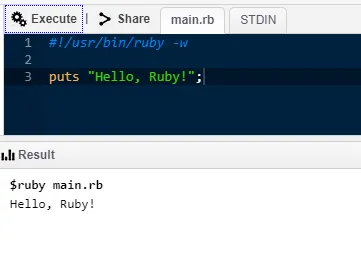
2. Yksinkertainen komento tulostaa useita rivijonoja EOF: n avulla
#!/usr/bin/ruby –w
print < Multiple line string.
First wayEOF
print <<"EOF"; # same as above
Multiple line string.
Second way
EOF#!/usr/bin/ruby –w
print < Multiple line string.
First wayEOF
print <<"EOF"; # same as above
Multiple line string.
Second way
EOF
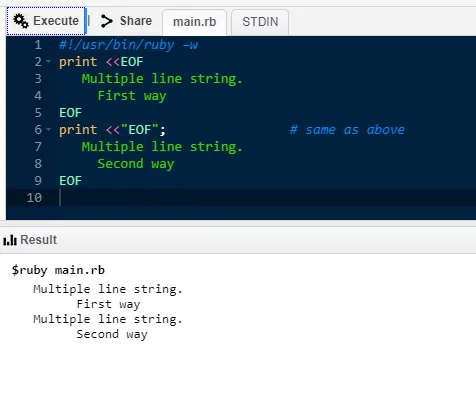
3. Yksinkertainen komento tulostaa monirivinen merkkijono suorittamalla komento
#!/usr/bin/ruby –w
print <<`EOC` # execute commands
echo First Statement
echo Second Statement
EOC

4. Yksinkertainen komento tulostaa useita rivijonoja pinoamalla.
#!/usr/bin/ruby –w
print <<"a", <<"b" # you can stack them
I said foo.
a
I said bar.
b

5. Ruby BEGIN -lausunto
#!/usr/bin/ruby
puts "This statement comes later"
BEGIN (
puts "This statement will be printed in the beginning"
)

6. Ruby END -lausunto
#!/usr/bin/ruby
puts "This is main body"
END (
puts "This block executes in the end"
)
BEGIN (
puts "This block executes in the beginning"
)

7. Ruby yhden rivin kommentti
#!/usr/bin/ruby
# This is a single line comment.
uts "This is not a comment" # This is again a single line
comment.
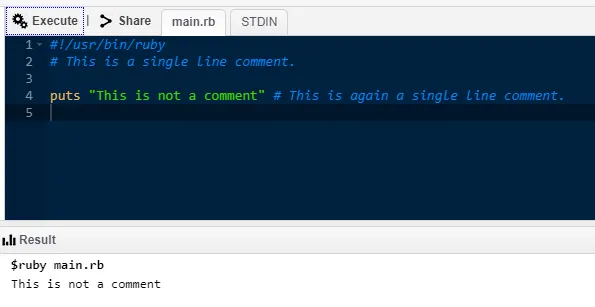
8. Rubiinin monirivinen kommentti
#!/usr/bin/ruby=begin
This is a multiple line comment.=end
puts "This is not a comment" # This is a single line comment.

9. Jäsentoiminto Ruby-luokassa. Objektin luominen ja menetelmän kutsuminen.
#!/usr/bin/ruby
class Demo
def testmethod
puts "Hello World!"
end
end
# Now using above class to create objects
object = Demo.new
object.testmethod

10. Globaalit muuttujat Rubyssa
#!/usr/bin/ruby
$globalvariable=123
class FirstClass
def printglobal
puts "Global variable in FirstClass is #$globalvariable"
end
end
class SecondClass
def printglobal
puts "Global variable in SecondClass is #$globalvariable
end
end
class1obj = FirstClass.new
class1obj.printglobal
class2obj = SecondClass.new
class2obj.printglobal
Keskikomennot
1. JOS… MUUT Ruby
#!/usr/bin/ruby
x = 1
if x > 2
puts "x is greater than 2"
elsif x <= 2 and x!=0
puts "x is 1"
else
puts "I can't guess the number"
end

2. Asia Rubyssa
<#!/usr/bin/ruby
$age = 17
case $age
when 0 .. 17
puts "Not eligible to vote"
when > 17
puts "Eligible to vote"
else
puts "incorrect age"
end
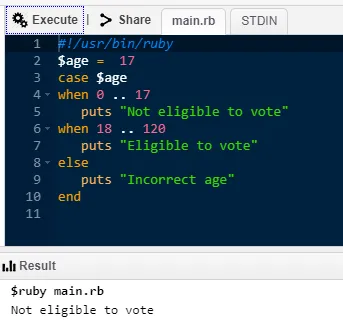
3. Silmukat Ruby
- 3.1. Vaikka silmukka
#!/usr/bin/ruby
$i = 0
$num = 10
while $i <
$num do
puts("Inside the loop i = #$i" )
$i = $i + 1
end
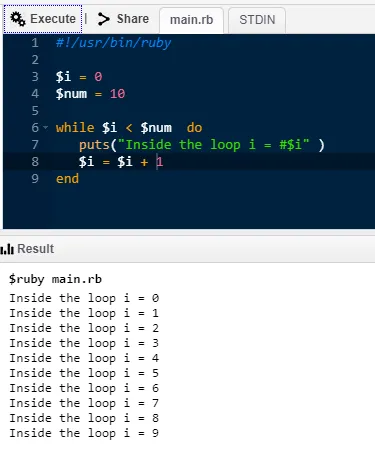
- 3.2. Kunnes Loop
#!/usr/bin/ruby
$i = 0
$num = 4
until $i > $num do
puts("Inside the loop i = #$i" )
$i = $i + 1;
end

- 3.3. Loopille
#!/usr/bin/ruby
for i in 0..9
puts "Local variable value is #(i)"
end
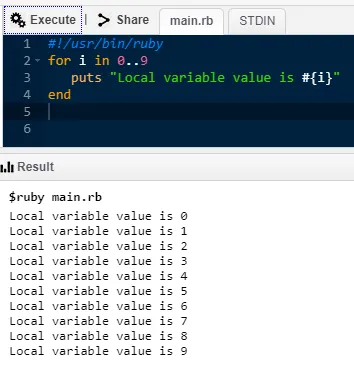
- 3.4. Break lausunto
#!/usr/bin/ruby
for i in 0..5
if i > 3 then
break
end puts "Local variable is #(i)"
end

- 3.5. Seuraava lausunto
#!/usr/bin/ruby
for i in 0..10
if i < 6 then
next
end
puts "Local variable is #(i)"
end
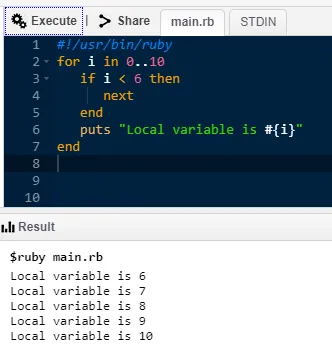
4. Menetelmän syntaksi Ruby-muodossa
#!/usr/bin/ruby
def test(a1 = "Noodles", a2 = "Pasta")
puts "The food is #(a1)"
puts "The food is #(a2)"
end
test "Burger", "Pizza"
test

5. Palautuslausunto rubiinina
#!/usr/bin/ruby
def testreturn
a = 10
b = 20
c = 30
return a, b, c
endvar1 = testreturn
puts var1
6. Parametrisoitu menetelmä Rubyssa
#!/usr/bin/ruby
def sample (*testparam)
puts "The number of parameters are #( testparam.length)"
for i in 0… testparam.length
puts "The parameters are #(testparam(i))"
end
end
sample "Hello", "123", "ABC", "Programming"
sample "World", "456", "Ruby"
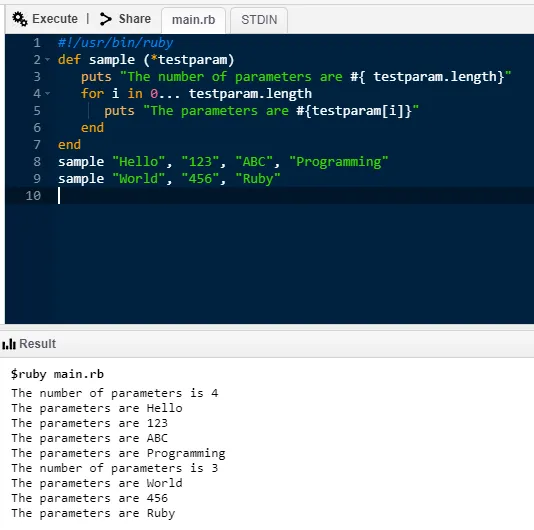
7. Toteutuslohko tuottolaskelman avulla
#!/usr/bin/ruby
def test
yield
end
test( puts "Hello world")

8. BEGIN- ja END-lohkot Rubyssa
#!/usr/bin/ruby
BEGIN ( # BEGIN block code
puts "BEGIN code block"
)
END (
# END block code
puts "END code block"
)
# MAIN block code
puts "MAIN code block"

9. String-lausekkeen substituutio rubiinissa
#!/usr/bin/ruby
a, b, c = 1, 2, 3
puts "The value of a is #( a )."
puts "The sum of b and c is #( b + c )."
puts "The average is #( (a + b + c)/3 )."

10. Ryhmän luominen Rubyssa
#!/usr/bin/ruby
names = Array.new(10)
puts names.size # returns 10
puts names.length # returns 10
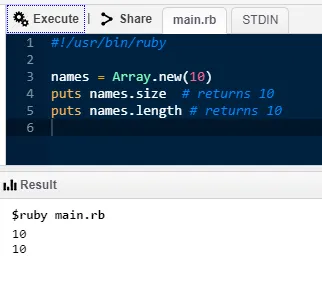
Advanced Ruby -komennot
1. Getter- ja Setter-menetelmät Rubyssa
#!/usr/bin/ruby -w
# defining a class
class Box
# constructor method
def initialize(l, b, h)
@length, @width, @height = l, b, h
end
# accessor methods
def printLength
@length
end
def printBreadth
@breadth
end
def printHeight
@height
end
end
# create
an object
box = Box.new(10, 30, 40)
# use accessor methods
l = box.printLength()
b = box.printBreadth()
h = box.printHeight()
puts "Box Length : #(l)"
puts "Box Breadth : #(b)"
puts “Box Height : #(h)”

2. Yhteisten yhdyskäytävärajapintaohjelmien kirjoittaminen Rubyn avulla
#!/usr/bin/ruby "
require 'cgi'
cgi = CGI.new
puts cgi.header
puts "This is a test
3. Pistorasio-ohjelmointi Rubyn avulla
- 3.1. Yksinkertainen esimerkki palvelimesta, joka käyttää Ruby-palvelua
require 'socket' # Get sockets from stdlib
server = TCPServer.open(8090) # listen on port 8090
loop ( # Running the server infinitely
client = server.accept # Connecting client wait time
client.puts(Time.now.ctime) # send time to client
client.puts "Closing the connection!"
client.close # Client disconnect
)
- 3.2. Yksinkertainen esimerkki asiakkaasta, joka käyttää Ruby-palvelua
require 'socket' # Get socket from stdlib
hostname = 'localhost' # Set hostname
port = 8090 # Set portsock = TCPSocket.open(hostname, port)
while line = sock.gets # Read lines from the socket
puts line.chop # print with platform line terminator
end
sock.close # Socket closing
4. Monisäikeinen esimerkki Rubyssa
#!/usr/bin/ruby
def function1
i = 0
while i<=2
puts "function1 at: #(Time.now)"
sleep(2) i = i+1
end
end
def function2
j = 0
while j<=2
puts "function2 at: #(Time.now)"
sleep(1)
j = j+1
end
end
puts "Started At #(Time.now)"
t1 = Thread.new(function1())
t2 = Thread.new(function2())
t1.join
t2.join
puts "End at #(Time.now)"
Vihjeitä ja vinkkejä Ruby-komentojen käyttämiseen
Koska mikä tahansa ohjelmointikielen käsittely vaatii tietämystä ja halua päivittää, tämä tapaus ei ole poikkeus. Peruskäskyjen käyttö ja komentojen harjoittelu ja hallitseminen on avain tämän kauniin kielen hallitsemiseen.
Johtopäätös - Ruby-komennot
Ruby-komento on ilmainen ja avoimen lähdekoodin ohjelmointikieli; se on joustava ja monipuolinen. Kuten nimestä voi päätellä, rubiini on todellakin jalokivi, jonka maahantulokustannukset ovat erittäin alhaiset. Sen plug and play -ominaisuus ja helposti luettava syntaksi tekevät siitä erittäin käyttäjäystävällisen. Se on edistyksellinen komentosarjojen tiivistelmä myös suosionsa suhteen.
Suositellut artikkelit
Tämä on opas Ruby-komentoihin. Täällä olemme keskustelleet perus Ruby-komennoista ja joistakin Ruby-komennoista. Voit myös tarkastella seuraavaa artikkelia saadaksesi lisätietoja.
- Kuinka käyttää seleenikomentoja?
- Suosituimmat kipinäkomennot
- HBase-komennot
- Kuinka Tableau-komentoja käytetään?
- Socket-ohjelmointi Pythonissa